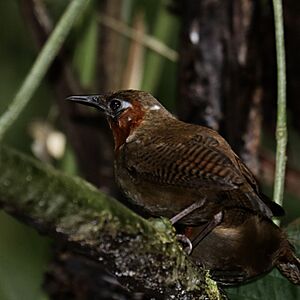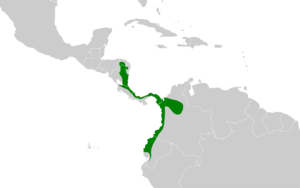Song wren facts for kids
Quick facts for kids Song wren |
|
|---|---|
 |
|
| In Panama | |
| Conservation status | |
| Scientific classification | |
| Genus: |
Cyphorhinus
|
| Species: |
phaeocephalus
|
 |
|
The song wren (Cyphorhinus phaeocephalus) is a small bird known for its beautiful voice. It belongs to the Troglodytidae family, which includes many types of wrens. You can find this bird in countries like Colombia, Costa Rica, Ecuador, Honduras, Nicaragua, and Panama.
Contents
About the Song Wren
Birds are often grouped by how they are related. Scientists once thought the song wren was the same species as the musician wren. Now, they know they are different but still very close relatives. These two, and maybe the chestnut-breasted wren, form a special group called a superspecies.
There are six slightly different types, or subspecies, of the song wren. These are:
- C. p. richardsonii
- C. p. infuscatus
- C. p. lawrencii
- C. p. propinquus
- C. p. chocoanus
- C. p. phaeocephalus
What Does a Song Wren Look Like?
The song wren is a small bird, about 11.5 to 12.5 cm (4.5 to 4.9 in) long. That's about the length of your hand! It weighs around 25 to 26 g (0.88 to 0.92 oz), which is like a few quarters.
Its body is mostly brown. Sometimes its chest is a bit lighter brown. It has a reddish-brown throat. You might notice black stripes on its wings and its very short tail. A cool feature is the patch of bare blue skin around its eye. Each subspecies has small differences in its color.
Where Do Song Wrens Live?
Song wrens live in different parts of Central and South America. Each subspecies lives in a specific area:
- C. p. richardsonii lives on the Caribbean side of southeastern Honduras and eastern Nicaragua.
- C. p. infuscatus is found on the Caribbean side of Costa Rica and northwestern Panama.
- C. p. lawrencii lives in central Panama and into the very northwestern part of Colombia.
- C. p. propinquus is found in northern Colombia.
- C. p. chocoanus lives in western Colombia.
- C. p. phaeocephalus ranges from southwestern Colombia to southern Ecuador.
These birds like to live deep inside old and new forests. They especially like areas with lots of plants growing close to the ground. They don't like dry places or areas that are too open and sunny.
How Song Wrens Behave
Finding Food
Song wrens spend almost all their time looking for food on the forest floor. They dig through fallen leaves and poke around to find tasty treats. You'll usually see them in pairs or small family groups. Their diet mainly consists of spiders and other small bugs.
Life Cycle and Nests
Song wrens build two kinds of nests. Some are "dormitory nests" where they sleep. Others are "breeding nests" where they lay eggs and raise their young. Both types of nests are shaped like gourds. They are made from small roots, pieces of palm leaves, and tiny twigs. The inside is often lined with leaf skeletons.
Breeding nests have a special cup shape inside, sometimes lined with soft feathers. These birds build and take care of their nests almost all year long. They often place their breeding nests in small trees, especially Acacia trees. These trees sometimes have ants called Pseudomyrmex living on them. Only the female song wren sits on the eggs and takes care of the baby birds.
Singing and Sounds
The song wren's song is very special. People describe it as "clear, beautiful whistles" mixed with "harsh, hen-like clucking" sounds. Both male and female song wrens sing all year to protect their territory. Scientists have noticed that their songs can be different depending on whether it's a male or female, or where the bird lives. However, more study is needed to understand these differences fully.
Song Wren Status
The IUCN (International Union for Conservation of Nature) has listed the song wren as a species of "Least Concern." This means they are not currently in danger of disappearing. They are quite common across the large areas where they live. However, changes to their forest homes, like cutting down trees, seem to affect them negatively. Their numbers are thought to be slowly going down.


